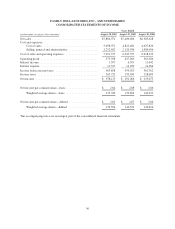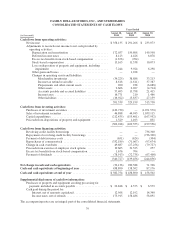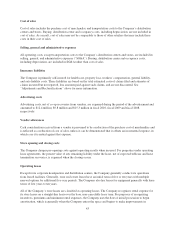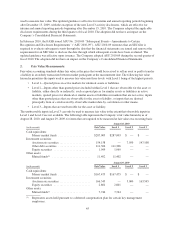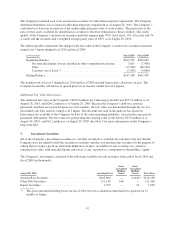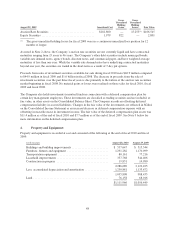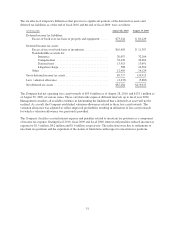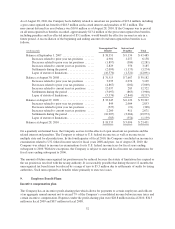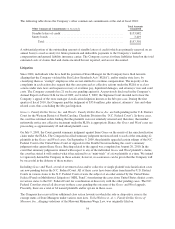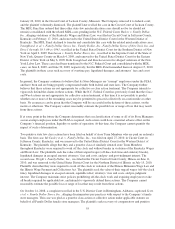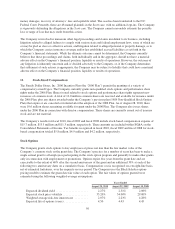Family Dollar 2010 Annual Report Download - page 50
Download and view the complete annual report
Please find page 50 of the 2010 Family Dollar annual report below. You can navigate through the pages in the report by either clicking on the pages listed below, or by using the keyword search tool below to find specific information within the annual report.On a non-recurring basis, the Company adjusts certain property and equipment to fair value through impairment
charges. Property and equipment is reviewed for impairment whenever events or changes in circumstances
indicate that the carrying amount of an asset may not be recoverable. The fair value of the property and
equipment is determined based on a discounted cash flow analysis using Level 3 inputs. The Company estimates
future cash flows based on historical experience and its expectations of future cash flows. Impairment charges
were not material during fiscal 2010.
Auction Rate Securities
The Company’s investment securities include student loan auction rate securities that were measured at fair value
using either Level 2 or Level 3 inputs. The auction rate securities are tax-exempt bonds that are collateralized by
federally guaranteed student loans. While the underlying securities generally have long-term nominal maturities
that exceed one year, the interest rates reset periodically in scheduled auctions (generally every 7-35 days). The
Company generally has the opportunity to sell its investments during such periodic auctions subject to the
availability of buyers.
Beginning in the second quarter of fiscal 2008, issues in the global credit and capital markets led to failed
auctions with respect to substantially all of the Company’s auction rate securities. A failed auction typically
occurs when the number of securities submitted for sale in the auction exceeds the number of purchase bids. As
of August 28, 2010, all of the Company’s $165.6 million par value investments were subject to failed auctions.
As a result of the failed auctions, the interest rates on the investments reset to the established rates per the
applicable investment offering statements. The Company will not be able to liquidate the investments until a
successful auction occurs, a buyer is found outside the auction process, the securities are called or refinanced by
the issuer, the securities are repurchased by the broker dealers, or the securities mature.
The Company does not currently expect to liquidate any auction rate securities going forward through the normal
auction process. However, the Company does expect to be able to liquidate substantially all of its remaining
auction rate securities at par through issuer calls or refinancings, repurchases by the broker dealers, or upon
maturity. During fiscal 2010, the Company liquidated $16.2 million of auction rate securities at par as a result of
issuer calls. Subsequent to the end of fiscal 2010, the Company liquidated an additional $7.1 million of auction
rate securities at par as a result of issuer calls. Because the Company received notice of the calls prior to the end
of fiscal 2010, the securities were classified as current assets on the Consolidated Balance Sheet and measured at
fair value using Level 2 inputs. The Company’s remaining auction rate securities were classified as long-term
assets due to the continued failure of the auction process and the continued uncertainty regarding the timing of
future liquidity, and were measured at fair value using Level 3 inputs, as discussed below.
Historically, the carrying value (par value) of the auction rate securities approximated fair market value due to
the resetting rates, and the Company had no cumulative gross unrealized or realized gains or losses from these
investments prior to fiscal 2008. However, due to the liquidity issues noted above, the Company had a temporary
gross unrealized loss of $11.4 million ($7.2 million, net of taxes) with respect to these investments as of
August 28, 2010. Changes in the unrealized loss are included in Accumulated Other Comprehensive Loss within
Shareholders’ Equity on the Consolidated Balance Sheets. Because there is no active market for the Company’s
auction rate securities, the fair value of each security was determined through the use of a discounted cash flow
analysis using Level 3 inputs. The terms used in the analysis were based on management’s estimate of the timing
of future liquidity, which assumes that the securities will be called or refinanced by the issuer or repurchased by
the broker dealers prior to maturity. The discount rates used in the analysis were based on market rates for similar
liquid tax-exempt securities with comparable ratings and maturities. Due to the uncertainty surrounding the
timing of future liquidity, the discount rates were adjusted further to reflect the illiquidity of the investments. The
Company’s valuation is sensitive to market conditions and management’s judgment and can change significantly
based on the assumptions used. A 100 basis point increase or decrease in the discount rate along with a 12-month
increase or decrease in the term could result in a gross unrealized loss ranging from $4.3 million to $21.4 million.
46


